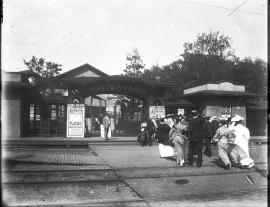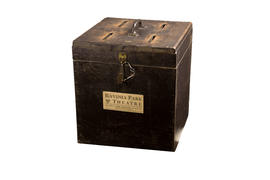Identity area
Reference code
Title
Date(s)
- Bulk, 1920-2000 (Creation)
- 1904 - 2003 (Creation)
Level of description
Collection
Extent and medium
11 Cubic Feet.
Context area
Name of creator
Biographical history
Name of creator
Administrative history
Ravinia was originally created as an amusement park when A.C. Frost purchased it in 1904. It was intended to lure people to the Chicago and Milwaukee Electric Railroad. The amusement park had a baseball diamond, an electric fountain and a casino building that could be used for dining and dancing. By 1910, Ravinia went into receivership; as the amusement park was not able to lure enough people to the railroad. A group of residents, convinced of the value of the park, purchased it and formed the Ravinia Company. The park re-opened in 1911, as a summer venue for classical music, under the leadership of Louis Eckstein. In 1912, opera was added to the concert program and was a main attraction throughout the “Golden Age” of opera until the 1930s. Many of opera’s biggest names performed at Ravinia. During the Depression, the park closed from 1932-1936. Louis Eckstein died in 1935; his widow donated the park to the festival association in 1944. In May 1949, the original wooden pavilion burned down. Six weeks later, the park opened on schedule ready to proceed with its summer programming. The first music director, Seiji Ozawa, was appointed in 1964. During the 1970s, concert opera performances returned. By the 1980s, the festival expanded to include a professional studies division, the Steans Music Institute. During the 1990s, Zarin Mehta, CEO of Ravinia pioneered the jazz festival-within-a-festival and oversaw the renovation of many of the park’s physical facilities. By the late 1990s, the summer music program was expanded. By the turn of the 21st century, Welz Kauffman, the president and CEO of Ravinia, created a music theater initiative which sought to recognize influential composers of music theater. A new music theater branch was added to the Steans Music Institute, focusing on the role of an orchestra in Music Theater. Most recently, Ravinia has focused on community outreach and providing educational opportunities. The festival runs educational programs throughout Chicago public schools. In 2003, One Score, One Chicago was introduced to promote interest in classical music. Today, Ravinia continues to bring many different types of great music to the community, both through great performances and educational opportunities.
Resource: http://www.ravinia.org/History.aspx.
Repository
Archival history
This collection was created by founders and other members of the Highland Park Historical Society from diverse sources and donations.
Immediate source of acquisition or transfer
Please see archivist for accession records.
Content and structure area
Scope and content
This artificial collection, created by the Highland Park Historical Society, contains records relating to the Ravinia Park in Highland Park, IL. The collection contains records relating to Ravinia's history, construction, opening and annual festival. The collection also contains photographs of the park as well as newsletters that contain articles about the park. The dates of the materials range from the early 20th century to the early 21st century; the bulk of the material dates from the 20th century.
Appraisal, destruction and scheduling
Accruals
System of arrangement
Box 1 contains photographs and written records.
Box 2 contains oversized materials.
Boxes 3, 10, 13 contains Ravinia Festival Programs 1900 - 1939, Children's Afternoon programs.
Box 4 contains Ravinia Festival Programs 1940-1982.
Box 5 contains Ravinia Festival Programs.1983 - 1995
Box 6 contains Ravinia Festival Programs 1996 - 2003.
Box 7 contains Ravinia Room signage and props.
Box 8 contains Ravinia Room signage, props, history, correspondence, plans, and exhibit notes.
Boxes 9 and 10 contains Ravinia Room signage and Photographs.
Box 11 contains Ticket Box.
Box 15 Contains Japanese Lanterns.
Conditions of access and use area
Conditions governing access
None known.
Conditions governing reproduction
Language of material
- English
Script of material
Language and script notes
Physical characteristics and technical requirements
Finding aids
Allied materials area
Existence and location of originals
Ravinia Festival Association records are located at the Newberry Library in Chicago, Illinois.
Existence and location of copies
Materials from these collections have been digitized and are available on http://www.idaillinois.org/digital/collection/p16614coll51 . Items are been uploaded on a regular basis.
Related units of description
Notes area
Alternative identifier(s)
Access points
Subject access points
Place access points
Name access points
Genre access points
Description control area
Description identifier
Institution identifier
Rules and/or conventions used
Status
Level of detail
Dates of creation revision deletion
Language(s)
Script(s)
Sources
Archivist's note
Processed by Jami Thompson and Eve Mangurten.







